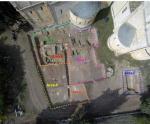Summary (English)
The 2017 excavations in the area next to the religious complex of Valva concentrated on areas A, C, and F (opened during previous campaigns), and in area E that was partially investigated during the 1990s. The latter is occupied by the late medieval funerary area alongside the south side of the oratory of S. Alessandro.
In area A, the stratigraphy for the construction site for the Romanesque cathedral of Valva emerged, in particular that relating to metal working activity. In the north-eastern part of the area the excavation continued of one of the two bell pits situated there. The draught flue was uncovered in addition to a nearby pit, probably used to dump the metal working waste. Another phase of use for the casting of a first bell was found below, of which the clay cordon c. 82 cm in diameter was preserved together with a surface, and the mouth of the furnace built of brick fragments. Therefore, the structure used for the casting of two bells was of the “pit with furnace” type and based on the excavation data can be attributed to a period between the late 11th and late 12th centuries.
In area C, the removal of the layers relating to the construction phase of the early medieval palace, whose plan was identified during previous campaigns, was completed revealing a moderately uniform stratigraphy. The latter was formed between late antiquity and the early medieval period and was partially constituted by residual material from the dismantling of the late antique funerary area that occupied this zone. The removal of this material revealed part of the palace’s foundations and the foundation offset of the opus reticulatum wall delimiting the area to the north on which the south wall of the oratory of S. Alessandro was built. In area F, the northern edge of the limekiln (identified last year) was found. The limekiln was part of the Romanesque building site. A brick-built hearth was uncovered abutting the east side of the campus wall. The edges of the hearth were cut by the construction of the left anta of the gate, which was opened in the late antique period in order to connect the campus with the funerary area that had developed to the east. Finally, excavations continued in area E where the late medieval cemetery alongside the Romanesque complex overlay what was preserved of the late antique necropolis. About ten burials in earth graves were excavated, some characterized by brick/tile fragments placed edgewise to contain the deceased’s head. Three ossuaries were identified but only partially excavated, constituted by simple sub-circular pits characterized by the presence of a block of limestone used as a grave marker.
- Maria Carla Somma, Sonia Antonelli, Vasco La Salvia, Università degli Studi “G. d’Annunzio” Chieti
Director
- Maria Carla Somma, Sonia Antonelli, Vasco La Salvia, Università degli Studi “G. d’Annunzio” Chieti
Team
- Chiara Casolino and Carmen Tanga- Università degli Studi “G. d’Annunzio” Chieti
- Antonio Baliva-Università degli Studi “G. d’Annunzio” Chieti
- Loredana Pompilio- niversità degli Studi “G. d’Annunzio” Chieti
- Lucia Marinangeli- niversità degli Studi “G. d’Annunzio” Chieti
- Marco Cardinale- niversità degli Studi “G. d’Annunzio” Chieti
Research Body
- Università degli Studi “G. d’Annunzio” Chieti
Funding Body
- Dipartimento di Scienze Psicologiche, della Salute e del Territorio (DisPUTer), Università degli Studi “G. d’Annunzio” Chieti






![Download [PDF]](/excavation/skins/fasti/images/results/download_sml.png)
